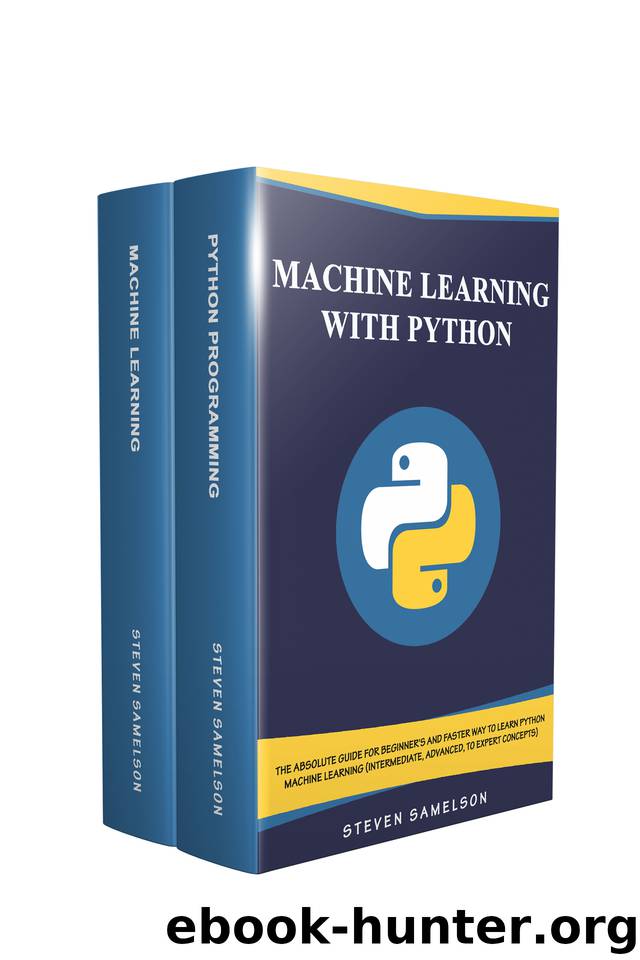Machine Learning with Python: The Absolute Guide for Beginner's and Faster Way To Learn python machine learning (Intermediate, Advanced, To Expert Concepts) by Samelson Steven

Author:Samelson, Steven [Samelson, Steven]
Language: eng
Format: epub
Published: 2020-06-08T16:00:00+00:00
Relations To Other Fields
As an interdisciplinary discipline, machine learning shares common threads with the scientific areas of statistics, optimization, information theory, and game theory. It is naturally a branch of computer science, as we aim to program machines to make them learn. In a sense, machine learning can be seen as a branch of Artificial Intelligence (AI), since, after all, the ability to detect meaningful patterns in complex sensory data or to turn the experience into expertise is a cornerstone of human (and also animal) intelligence. However, one should take note that, in contrast with traditional AI, machine learning is not trying to build an automated imitation of intelligent behavior, but rather to use the strengths and special skills of computers to enhance human intelligence, often carrying out some tasks that fall way beyond human capacities. For instance, the ability to scan and process huge databases permits machine learning programs to detect patterns which are outside the scope of human perception.
The component of the training, or experience, in machine learning often points to data that is randomly generated. The responsibility of the learner is to process such randomly generated examples toward drawing conclusions that hold for the setting from which these examples are picked. This description of machine learning talked about its close relationship with statistics. There is a lot in common among the two disciplines, in terms of objectives and techniques used. There are, however, some significant differences in emphasis; If a doctor raises the hypothesis that there is a correlation between heart disease and smoking, it is the statistician's duty to observe the patient's samples and verify the validity of this hypothesis (this is the popular statistical task of hypothesis testing). In other words, machine learning intends to use the data collected from patient samples to get a description of what causes heart disease. The hope is that automated techniques will also be able to discover significant patterns (or hypotheses) that the human observer might have omitted.
In contrast to traditional statistics, in machine learning in general and in this book in particular, algorithmic considerations play an important role. Machine learning refers to performing computer learning; therefore, algorithmic problems are fundamental. We develop algorithms to perform learning tasks, and we are involved with your computational efficiency. Another difference is that while statistics are often interested in asymptotic behavior (such as the convergence of statistical estimates based on samples when the sample size increases indefinitely), machine learning theory focuses on the limits of finite samples. That is, given the size of the available samples, machine learning theory aims to determine the degree of precision a student can expect from these examples.
There are more differences between these two disciplines, of which we will mention only one other here. While in statistics it is popular with working under the assumption of specific models of pre-subscribed data (such as the linearity of functional dependencies or the assumption of the normality of data generation distributions), in machine learning the emphasis is on working under
Download
This site does not store any files on its server. We only index and link to content provided by other sites. Please contact the content providers to delete copyright contents if any and email us, we'll remove relevant links or contents immediately.
Baby Bird by Seven Rue(1852)
CLICK'D by Tamara Ireland Stone(1754)
Minecraft by Mojang Ab(1639)
The Game of Lives by James Dashner(1601)
Olivia Twisted (Entangled Teen) by Vivi Barnes(1551)
The Rule of Thoughts by James Dashner(1514)
Getting Started with the micro:bit by Wolfram Donat(1469)
Mission Python by Sean McManus(1390)
The Mortality Doctrine 01: The Eye of Minds by James Dashner(1347)
Flynn's Log 1 by Stone Marshall(1345)
A Warning by Anonymous(1310)
The Rule of Thoughts (Mortality Doctrine, Book Two) by James Dashner(1290)
CODE by Petzold Charles(1211)
Girls Who Code: Learn to Code and Change the World by Reshma Saujani(1170)
Only You Can Save Mankind by Pratchett Terry(1143)
The Memory Wall by Lev AC Rosen(1098)
TBH, This Is So Awkward by Lisa Greenwald(1086)
The Code Book - HOW TO MAKE IT, BREAK IT, HACK IT, CRACK IT by Simon Singh(1048)
App of the Living Dead by Kim Harrington(1043)
